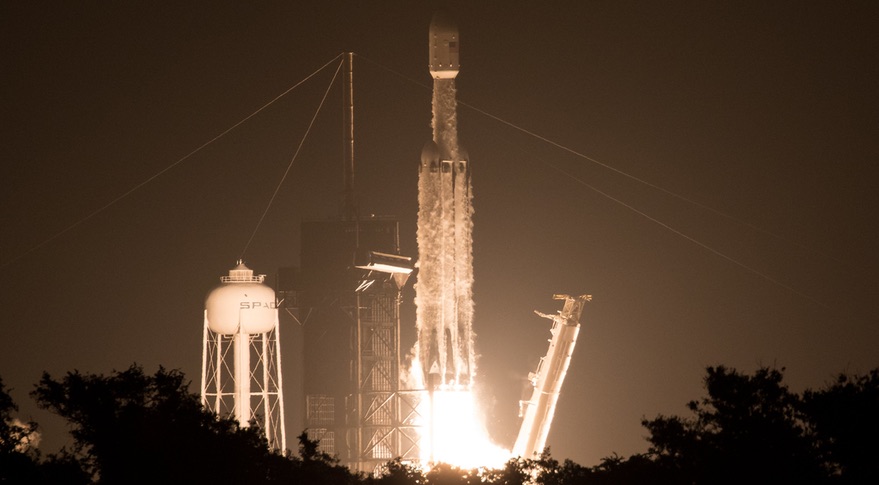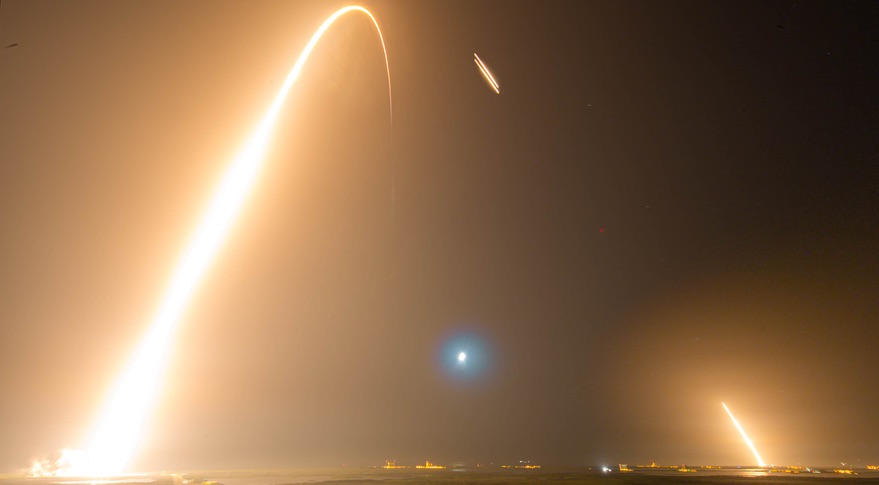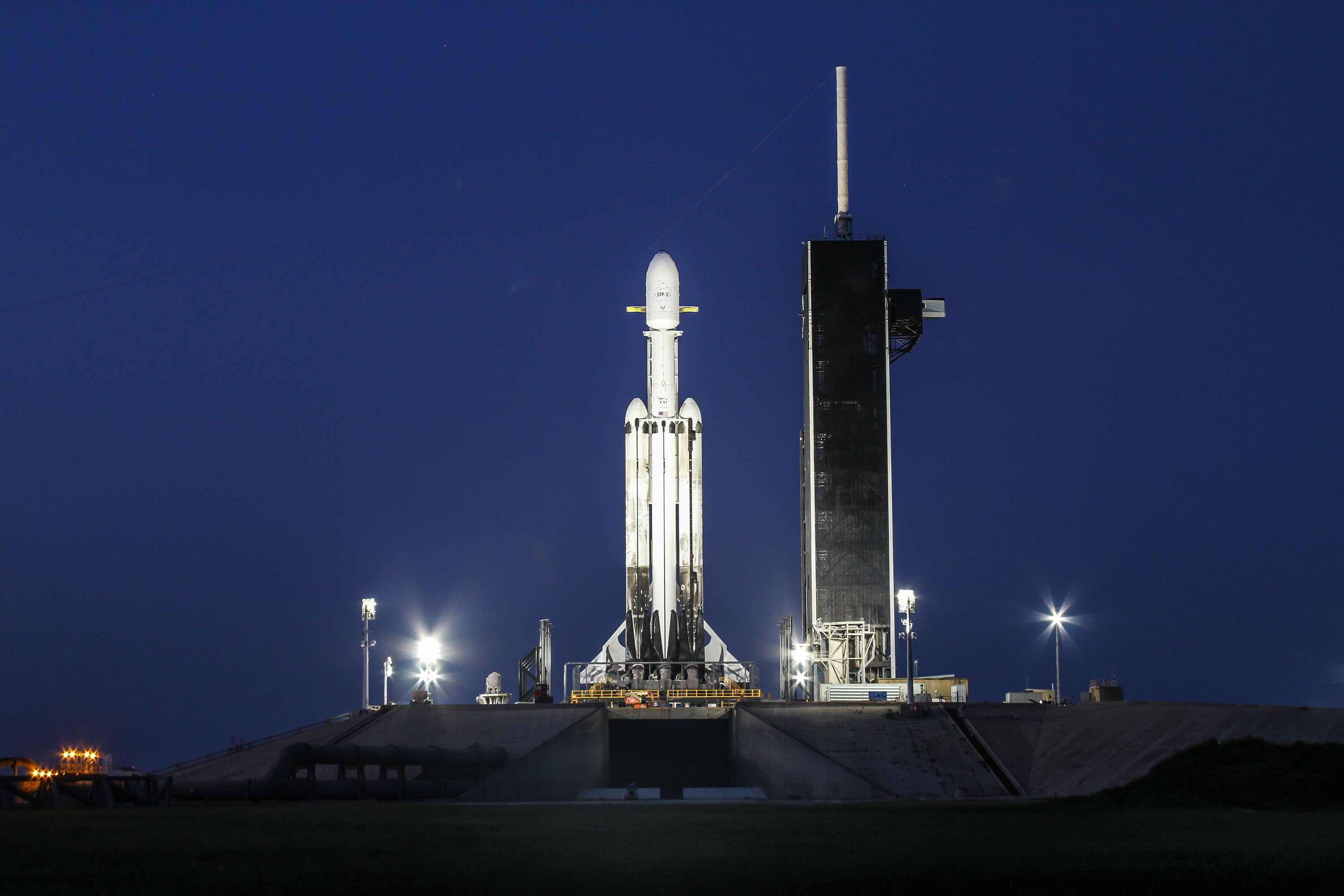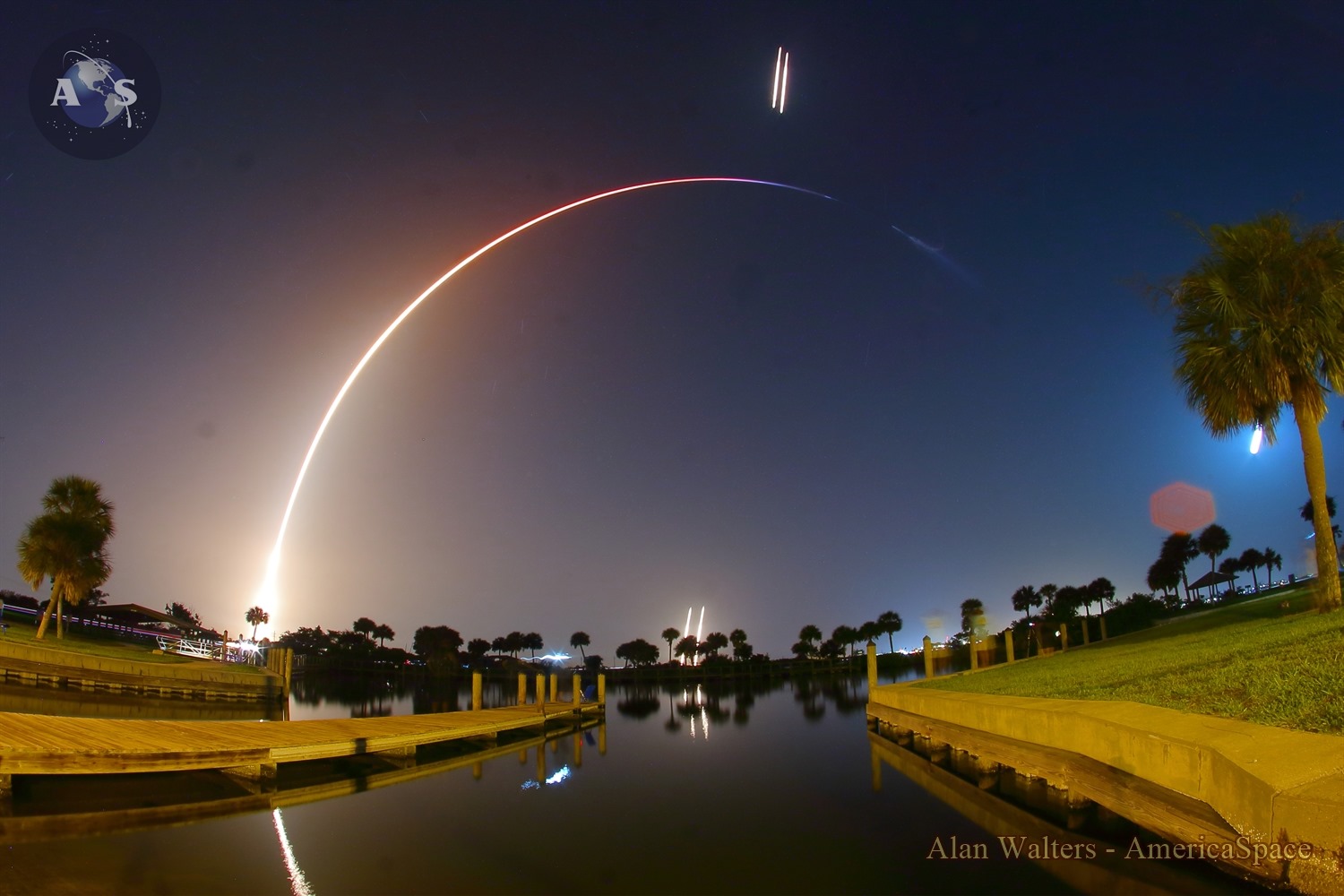Trzeci start ciężkiego Falcona 25.06. o 06:30 z KSC wystrzelona została RN Falcon Heavy, która wyniosła w ramach misji STP-2 satelity: DSX
(SSTE 4, Cygnus, SET 1), FORMOSAT 7A/7B/7C/7D/7E/7F (COSMIC-2A equatorial), GPIM+AFIT SOS, OTB 1,
NPSat 1, Oculus-ASR, Prox 1 + LightSail B, E-TBEx A, E-TBEx B, PSat 2, TEPCE 1, TEPCE 2, STP-2: BRICSat 2,
FalconSat 7 (FS 7, Peregrine), ELaNa XV: ARMADILLO, CP 9 (LEO) i StangSat. Oculus i cubesaty zostały umieszczone
na orbicie o przybliżonych parametrach: hp=300 km, ha=860 km, i=28,5°, Prox-1, NPSat, OTB, GPIM, COSMIC-2
na orbicie o przybliżonych parametrach: hp=720 km, ha=720 km, i=24°, a DSX na orbicie o przybliżonych parametrach: hp=600 km, ha=12000 km, i=43°. Dwie rakiety boczne wylądowały w T+8' 41" na LZ-1 i LZ-2, stopień centralny nie trafił w T+11' 21" w barkę ASDS OCISLY na Atlantyku, udało się (po raz pierwszy) pochwycić połówkę osłony startowej.
http://lk.astronautilus.pl/n190616.htm#04Po korekcie:
25.06. o 06:30 z KSC wystrzelona została RN Falcon Heavy, która wyniosła w ramach misji STP-2 satelity: DSX
(Demonstration & Science Experiments, SSTE 4), FORMOSAT 7A/7B/7C/7D/7E/7F (COSMIC-2A equatorial), GPIM,
OTB 1, NPSat 1, Oculus-ASR, Prox 1, LightSail B, ARMADILLO, FalconSat 7 (FS 7, Peregrine), E-TBEx A, E-TBEx B,
PSat 2, BRICSat 2, TEPCE 1, TEPCE 2, Prometheus 2.6, Prometheus Mass Model, CP 9 (LEO) i StangSat. Oculus i cubesaty zostały umieszczone na orbicie o przybliżonych parametrach: hp=300 km, ha=860 km, i=28,5°, Prox-1, NPSat, OTB, GPIM, COSMIC-2 na orbicie o przybliżonych parametrach: hp=720 km, ha=720 km, i=24°, a DSX na orbicie o przybliżonych parametrach: hp=600 km, ha=12000 km, i=43°. Dwie rakiety boczne wylądowały w T+8' 41" na LZ-1 i LZ-2, stopień centralny nie trafił w T+11' 21" w barkę ASDS OCISLY na Atlantyku, udało się (po raz pierwszy) pochwycić połówkę osłony startowej.
Falcon Heavy – start STP-2 BY KRZYSZTOF KANAWKA ON 25 CZERWCA 2019
 Start rakiety Falcon Heavy - 25.06.2019 / Credits - SpaceX
Start rakiety Falcon Heavy - 25.06.2019 / Credits - SpaceXDwudziestego piątego czerwca nastąpił udany start rakiety Falcon Heavy w ramach misji STP-2. Z uwagi na zainstalowane satelity, misja miała bardzo nietypowy przebieg.
Do startu rakiety Falcon Heavy doszło 25 czerwca o godzinie 08:30 CEST, pod koniec trzygodzinnego okienka startowego. Start nastąpił z wyrzutni LC-39A. Na pokładzie rakiety Falcon Heavy znalazły się 24 satelity oraz “balast”. Większość z tych satelitów to CubeSaty, z których część powstała na uniwersytetach, zaś część przy współpracy z NASA. Dla Falcona Heavy był to pierwszy nocny start.
Głównym celem tej misji była demonstracja możliwości Falcona Heavy dla potrzeb amerykańskiego wojska. Z tego też powodu rakieta Falcon Heavy wyniosła szereg ładunków na kilka orbit o różnych wysokościach. Jest to dość nietypowa zdolność Falcon Heavy – rakiety o dużych zdolnościach wynoszenia ładunku, choć oczywiście dużo zależało od poprawnej pracy górnego stopnia.
Rozmieszczanie 24 satelitów na różnych orbitach trwało kilka godzin. Łączna masa startowa ładunku wyniosła zaledwie 3700 kg – niewiele jak na możliwości rakiety Falcon Heavy. Ostatni satelita został zwolniony około trzy godziny i trzydzieści minut po starcie.
Podobnie jak w poprzednich startach rakiet Falcon Heavy, i tym razem doszło do próby lądowania pierwszego stopnia. Dwa człony boczne (“boostery”) lądowały na lądzie na Florydzie bez problemu. Centralny człon miał lądować na platformie morskiej, znajdującej się około 1200 km od miejsca startu. Dla firmy SpaceX był to najtrudniejsze z dotychczasowych lądowań. Niestety, to lądowanie nie było udane – rakieta uderzyła w wody Atlantyku, blisko platformy morskiej. Udało się natomiast odzyskać jedną z owiewek osłony aerodynamicznej.
 Eksplozja centralnego członu pierwszego stopnia Falcona Heavy nieopodal platformy morskiej – 25.06.2019 / Credits – SpaceXLądowanie członów pierwszego stopnia Falcona Heavy – 25.06.2019 / Credits – SpaceX
Eksplozja centralnego członu pierwszego stopnia Falcona Heavy nieopodal platformy morskiej – 25.06.2019 / Credits – SpaceXLądowanie członów pierwszego stopnia Falcona Heavy – 25.06.2019 / Credits – SpaceXBył to trzeci start rakiety Falcon Heavy.
Pierwszy start tej dużej rakiety (6 lutego 2018) wyniósł samochód – Teslę Roadster – na eliptyczną orbitę heliocentryczną. Orbita Tesli (oraz górnego stopnia) przecina orbity Ziemi oraz Marsa.
Drugi start Falcona Heavy miał charakter komercyjny – na pokładzie rakiety znalazł się duży satelita telekomunikacyjny ArabSat-6A.
(SpaceX)
https://kosmonauta.net/2019/06/falcon-heavy-start-stp-2/#prettyPhotoSukces LightSail 2
https://www.forum.kosmonauta.net/index.php?topic=2129.msg139683#msg139683Falcon Heavy launches STP-2 missionby Jeff Foust — June 25, 2019
 A SpaceX Falcon Heavy lifts off from Launch Complex 39A June 25 on the Space Test Program 2 mission. Credit: NASA/Joel Kowsky
A SpaceX Falcon Heavy lifts off from Launch Complex 39A June 25 on the Space Test Program 2 mission. Credit: NASA/Joel KowskyWASHINGTON — A SpaceX Falcon Heavy lifted off early June 25 carrying two dozen small satellites on a mission to demonstrate the rocket’s capabilities for the U.S. Air Force.
The Falcon Heavy lifted off at 2:30 a.m. Eastern from Launch Complex 39A at the Kennedy Space Center. The launch took place three hours into a four-hour launch window, delayed by a problem with a ground hydraulics system.
The rocket’s two side boosters made synchronized landings on neighboring pads at the former Launch Complex 13 at Cape Canaveral Air Force Station, several kilometers to the south of the launch site. Both side boosters also flew on the previous Falcon Heavy mission, launching the Arabsat-6A satellite in April.
The rocket’s center booster attempted a landing on a droneship more than 1,200 kilometers from the launch site in the Atlantic Ocean. Video from that droneship show it crashing in the ocean near the ship, which was unharmed.
SpaceX had warned that the center core booster landing would be difficult given its high-speed reentry. “Odds of center core surviving are about 50% [in my opinion], as it’s coming in about 4 times faster than a rifle bullet,”
tweeted SpaceX Chief Executive Elon Musk several hours before the launch.
“Center core RUD,” or “rapid unscheduled disassembly,” Musk
tweeted after the launch. “It was a long shot.
SpaceX, which has made landings of Falcon 9 first stages routine in recent years, has been unable to return the center booster on the three Falcon Heavy launches to date. The booster just missed the droneship on the rocket’s inaugural launch in February 2018. The booster did land on the droneship on the Arabsat-6A mission in April, but toppled in heavy seas before crews could secure the stage to the ship’s deck.
The company did achieve another milestone with the launch, though. SpaceX reported a ship equipped with a large net caught one of the two payload fairing halves, part of a long-running effort to catch and eventually reuse those components.
 A time lapse of the Falcon Heavy launch, showing the rocket ascending from Launch Complex 39A and the two side boosters returning several kilometers away at Cape Canaveral Air Force Station. Credit: Craig Vander Galien
A time lapse of the Falcon Heavy launch, showing the rocket ascending from Launch Complex 39A and the two side boosters returning several kilometers away at Cape Canaveral Air Force Station. Credit: Craig Vander GalienThe rocket lifted off to start the Space Test Program (STP) 2 mission for the Air Force’s Space and Missile Systems Center. The rocket carried 24 satellites, with a total mass, including adapters, of 3,700 kilograms.
Deployment of the satellites started less than 13 minutes after liftoff, shortly after the second stage completed its first burn and reached orbit. The final payload was scheduled for release more than three and a half hours after liftoff, after three additional burns of the rocket.
The satellites are primarily science and technology demonstration missions for various organizations, including the Defense Department, NASA, NOAA and several universities. The include the six satellites of the COSMIC-2 system, developed by NOAA and Taiwan to collect GPS radio occultation data for weather forecasting, and NASA’s Green Propellant Infusion Mission, to test a new non-toxic or “green” propellant for satellites.
The Orbital Test Bed satellite, built by General Atomics Electromagnetic Systems (formerly Surrey Satellite Technology U.S.), carries several experiments, including NASA’s Deep Space Atomic Clock. That experiment will test the performance of a miniature but highly accurate clock that could aid in navigation for future deep space missions. The satellite is also carrying a payload from Celestis, a company that offers space memorial services, with cremated remains from more than 150 people.
The largest satellite on the mission, and the last to be deployed from the upper stage, is the Demonstration and Science Experiments (DSX) satellite from the Air Force Research Laboratory. Placed into an orbit of 6,000 by 12,000 kilometers, DSX will study the space radiation environment with various sensors, including the Space Environment Testbeds experiment from NASA.
While deploying the various satellites, STP-2 is intended to demonstrate the performance of the Falcon Heavy vehicle. The company described is as “among the most challenging launches in SpaceX history” because of the number of upper stage burns and deployments. The Air Force also planned to use the launch to gain experience with reused boosters.
https://spacenews.com/falcon-heavy-launches-stp-2-mission/https://spacenews.com/spacex-to-demonstrate-falcon-heavy-capabilities-in-difficult-test-flight/Watch Falcon Heavy Fly Its First Night Launch & DOD Mission TonightBy Ben Evans, on June 24th, 2019
 The third SpaceX Falcon Heavy rocket standing atop pad 39A at Kennedy Space Center, ahead of its first launch attempt scheduled for June 24 at 11:30pm Eastern time with the STP-2 mission. Photo: SpaceX
The third SpaceX Falcon Heavy rocket standing atop pad 39A at Kennedy Space Center, ahead of its first launch attempt scheduled for June 24 at 11:30pm Eastern time with the STP-2 mission. Photo: SpaceX
UPDATE 9:00pm Eastern June 24: SpaceX has delayed tonight’s planned launch from 11:30pm to ‘No Earlier Than’ 2:30am Eastern time.https://www.americaspace.com/2019/06/24/falcon-heavy-ready-for-first-night-launch-with-multitude-of-payloads/Falcon Heavy Delivers STP-2 on Spectacular First 'Night Shift' LaunchBy Ben Evans, on June 25th, 2019
 A single 8:41 second long-exposure captures the launch, ascent, stage separations and re-entry and landing burns of the Falcon Heavy, which delivered STP-2 to space for the Dept of Defense on its first night launch at 2:30am Eastern on 25 June 2019. Photo: Alan Walters / AmericaSpace.com
A single 8:41 second long-exposure captures the launch, ascent, stage separations and re-entry and landing burns of the Falcon Heavy, which delivered STP-2 to space for the Dept of Defense on its first night launch at 2:30am Eastern on 25 June 2019. Photo: Alan Walters / AmericaSpace.com(...) Looking ahead, the Falcon Heavy currently boasts at least four confirmed missions—two for commercial customers, two for the Department of Defense—through 2022. Scheduled for launch “late” in Fiscal Year 2020, the $130 million Air Force Space Command (AFSPC)-52 classified mission was firmly added to the Heavy’s books last October, in what Lt. Gen. Arnold Bunch, Jr., military deputy for the Office of the Assistant Secretary to the Air Force for Acquisition, described as the result of across-the-board financial savings both in “competition and also with commercial demand signal”. And more recently, in February 2019, contracts were signed between SpaceX and the Department of Defense to fly the $100 million AFSPC-44 aboard the Heavy “by February 2021”. (...)
https://www.americaspace.com/2019/06/25/falcon-heavy-delivers-stp-2-on-spectacular-first-night-shift-launch/https://www.americaspace.com/2019/06/24/falcon-heavy-ready-for-first-night-launch-with-multitude-of-payloads/Photos: Falcon Heavy reaches pad 39A for its first night launchJune 24, 2019 Stephen Clark
 Credit: Walter Scriptunas II / Spaceflight Nowhttps://spaceflightnow.com/2019/06/24/photos-falcon-heavy-reaches-pad-39a-for-its-first-night-launch/https://spaceflightnow.com/2019/06/24/launch-timeline-for-falcon-heavys-first-launch-for-the-u-s-air-force/https://spaceflightnow.com/2019/06/24/nasa-technology-experiments-hitching-a-ride-on-spacexs-falcon-heavy-rocket/Artykuły astronautycznehttps://space.skyrocket.de/doc_sdat/dsx.htmhttps://space.skyrocket.de/doc_sdat/formosat-7-cosmic-2.htm
Credit: Walter Scriptunas II / Spaceflight Nowhttps://spaceflightnow.com/2019/06/24/photos-falcon-heavy-reaches-pad-39a-for-its-first-night-launch/https://spaceflightnow.com/2019/06/24/launch-timeline-for-falcon-heavys-first-launch-for-the-u-s-air-force/https://spaceflightnow.com/2019/06/24/nasa-technology-experiments-hitching-a-ride-on-spacexs-falcon-heavy-rocket/Artykuły astronautycznehttps://space.skyrocket.de/doc_sdat/dsx.htmhttps://space.skyrocket.de/doc_sdat/formosat-7-cosmic-2.htm (6)
https://space.skyrocket.de/doc_sdat/gpim.htmhttps://space.skyrocket.de/doc_sdat/otb-1.htmhttps://space.skyrocket.de/doc_sdat/npsat1.htmhttps://space.skyrocket.de/doc_sdat/oculus-asr.htmhttps://space.skyrocket.de/doc_sdat/prox-1.htmhttps://space.skyrocket.de/doc_sdat/lightsail-1.htmhttps://space.skyrocket.de/doc_sdat/armadillo.htmhttps://space.skyrocket.de/doc_sdat/falconsat-7.htmhttps://space.skyrocket.de/doc_sdat/e-tbex.htmhttps://space.skyrocket.de/doc_sdat/e-tbex.htmhttps://space.skyrocket.de/doc_sdat/psat-2.htmhttps://space.skyrocket.de/doc_sdat/bricsat-2.htmhttps://space.skyrocket.de/doc_sdat/tepce.htmhttps://space.skyrocket.de/doc_sdat/tepce.htmhttps://space.skyrocket.de/doc_sdat/cp-9.htmhttps://space.skyrocket.de/doc_sdat/stangsat.htm